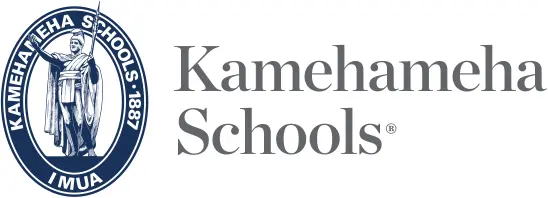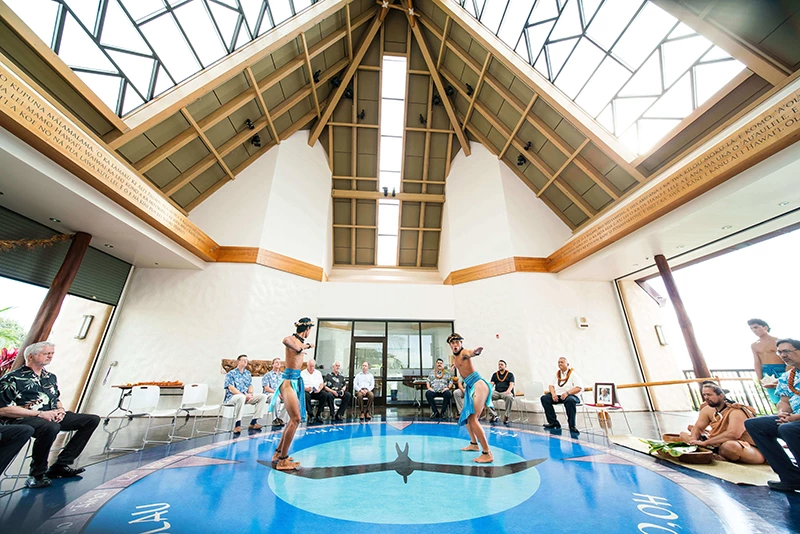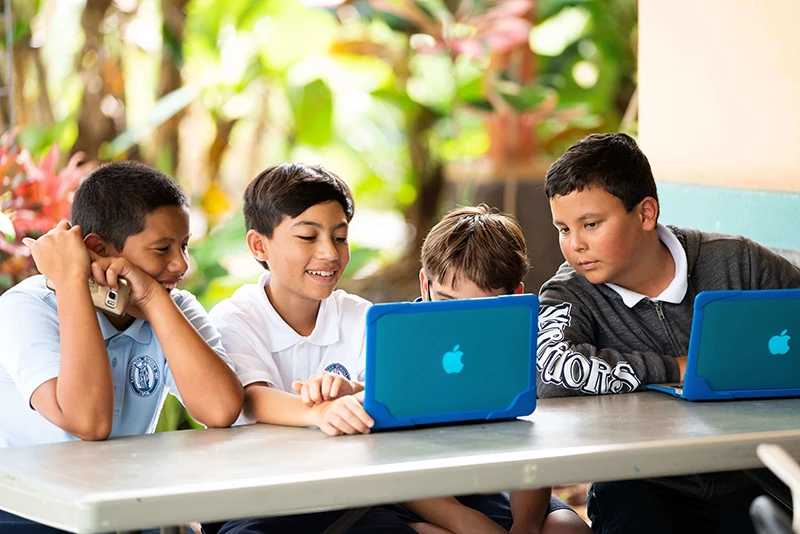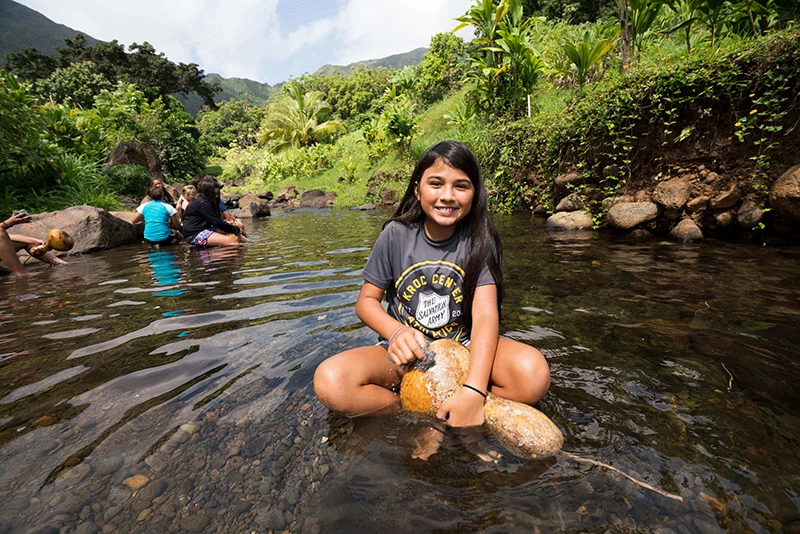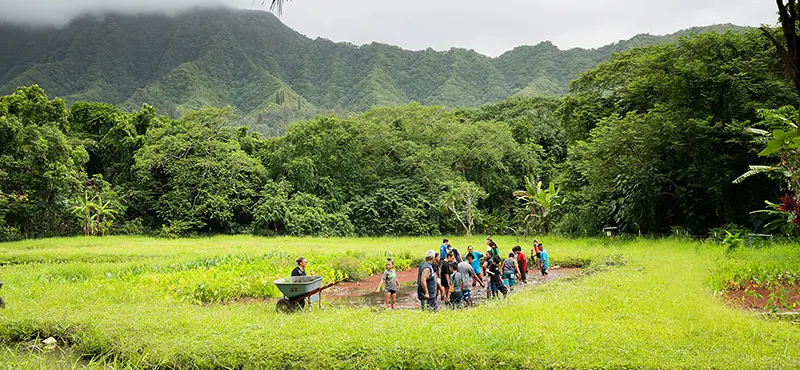Feb. 7, 2025

This mo‘olelo first appeared in the 2024 issue of I Mua magazin.e Read the full issue.
Story
Justin Barfield and Crystal Kua-Bikkle KSK'81
Photos
Jacob Chin and Chelsie Machado
Ola ke kaiaola, ola ke kaiāulu — If the ecosystem is healthy, the community is healthy. Our kuana‘ike informs both the “why” and the “how” when it comes to restoring Lahaina mai uka a i kai. Flourishing ‘āina and community are one and the same.
Since the devastating Lahaina wildfire, the kānaka ‘ōiwi of that place, still in mourning, have embraced the kuleana to be alaka‘i in this restoration effort.
As individual limahana and as an organization, Kamehameha Schools is uniquely poised to stand shoulder to shoulder with community to plant seeds of change today that will be transformational for generations to come.
“We have a great number of people in our organization that are contributing in ways big and small. For me personally, that meant working to meet the community where they are and to understand the depth and breadth of their needs,” said Nālani Blane Kealaiki KSK’94, a community strategist with Kamehameha Schools Hi‘ialo.
A Lahaina native, Kealaiki has worn many hats since the fire. Like so many, she pitched in to deliver supplies where needed during those desperate days and weeks that followed. Later, she would take on the role of facilitator and community connector. “Let Lahaina lead” has and continues to be her mantra.
“If I’m doing my job right, I am helping to ensure the voices of Lahaina are heard.”
Kealaiki is proud of this community-focused effort to reshape Lahaina, which includes a plan to transform nearly 1,100 acres of Kamehameha Schools’ ‘Āina Pauahi ma Ku‘ia in Lahaina.
Fellow community advocate and Lahaina native Carolyn Auweloa has been handling outreach for one of the early phases of the Ku‘ia plan. Located just above the Lahaina Bypass, Kamehameha Schools is planting native trees and food crops on a one-acre parcel, with plans to add more food trees on an adjoining one-acre parcel in 2025.
‘Ulu, kou, kamani, hao and milo will soon be flourishing here. Non-native grass will be removed and replaced with native shrubs and ground cover plants. The vision here is for the ‘āina to be a community gathering space, with the kaiāulu eventually taking the lead to mālama it.
Auweloa says the response to this effort has been overwhelmingly positive.
“It’s good for the community to see life coming back, to see this type of intention and this type of serving the land. I think it will give people hope and influence how people look at ‘āina. I think as it grows and matures, it will become more and more a place of refuge – a place of peace, healing and respite.”
Auweloa could barely hold back tears when describing the generational trauma from sugar cane and how restoration can foster healing.
“I’m really excited for the next chapter here at Ku‘ia. I grew up and these fields were sugar cane. But as I got older, I understood more and more the cost of that type of agriculture, what we were paying in the environment and in our different ecosystems. It’s a big part of our history. But to see and know that we’re entering a new era, one where food production would be coming back, but in a more community-focused way is exciting. And to be able to be a part of and witness agriculture making a comeback in West Maui is a dream I never thought that I would see happen.”
In order to restore the forest, in order to restore our streams and water resources in those areas, we need to plant native plants.
These plantings are happening right next to KS Kaiāulu partner Ku‘ia Agricultural Education Center, run by mahi‘ai extraordinaire Kaipo Kekona. More food crops are being planted there and KAEC’s greenhouse includes not only native plants but citrus trees.
“Today, we have a diversified palate. Everybody doesn’t want to just eat ‘ulu or kalo. We like our papayas, we like to add some different bananas,” Kekona said with a smile. “I like my pumpkins and my peppers…I like my Filipino food too.”
Increasing food production could translate to economic vibrancy as well.
“We could employ a lot of people who are displaced right now to help us build that food system in place as they build their house,” Kekona said.
The restoration of the dryland forest ma uka is a different kind of challenge in large part due to the sheer scale of the 1,000-acre-plus site.
“No one has ever done anything to the scale we’re trying to do there,” said Keola Lindsey, a cultural resources director for Kamehameha Schools’ ‘Āina Pauahi.
“Lahaina is, and for the last 100 years has become, a dry, arid space with very minimal rainfall and a decimated native forest. In order to restore the forest, in order to restore our streams and water resources in those areas, we need to plant native plants,” said Hōkūao Pellegrino, the ‘āina and sustainability facility and learning designer at Kamehameha Schools Maui.
The effort to fully restore the uka lands will take years and hundreds of thousands of native plants and seeds. While plans to scale up replanting are being developed, KS ‘āina stewards are working to nurture and protect the native species that have grown back on their own since the Aug. 8, 2023, wildfires.
“The invasive grass is very pervasive but in these small pockets, we see keiki of many native plants like ‘a‘ali‘i, pili and ‘ūlei, popping up voluntarily. We’re working to mālama these places so we will have more natural regeneration,” Kamehameha Schools’ natural resources manager R. Mililani Browning KSK’02 said.
“In similar spots, we even see our native sandalwood, ‘iliahialo‘e, that were burned in previous fires resprouting from its base, showing us just how resilient our native plant communities are. And our people are no different.”
But threats abound for these native species. Voracious ungulates such as invasive deer, wild pigs and goats could destroy existing native plants and future plantings. To address that issue, a fence will stretch across most of the perimeter of the ahupua‘a. Encircling the area will require 25,000 linear feet of fencing, which equates to nearly five miles of fencing.
A steady water supply is also crucial, and KS is in talks with Maui County and state officials to bring an R-1 water line to Ku‘ia. R-1 is recycled water that’s not drinkable but has been highly filtered. The golf courses and landscaping at resorts in nearby Kā‘anapali rely on R-1 water to stay lush and green, a stark contrast to the water-starved landscape of Ku‘ia just a few miles away.
The first plants to go into the ground ma uka may very well be ones nurtured by haumāna at the hale uliuli mau (greenhouse) on the KS Maui campus. In September 2024, some 3,000 ‘a‘ali‘i seeds from West Maui were germinated there. ‘A‘ali‘i are a great foundation for restoring the dryland forest because they are considered among the most resilient native plants in Hawai‘i.
Hōkūao Pellegrino is overseeing this effort, which provides haumāna from māhele lalo and māhele luna the chance to learn and connect with ‘āina and culture outside the traditional classroom.
“It’s important for the students to see and really work with their hands throughout the entire process,” Pellegrino said. “You can’t teach Hawaiian culture- based education and learn about E Ola! if ‘āina is not at the forefront. Everything in our language, everything in our cultural practices, everything around us, is tied to ‘āina. We’re teaching haumāna that you can’t segregate out certain portions of ‘āina-based practices like food systems and conservation. They truly are part of a collective effort and integrated approach.”
KS Maui haumāna are also raising a separate batch of ‘a‘ali‘i and wiliwili that will help restoration efforts near campus, and also in Kula, where another wildfire in August 2023 destroyed 25 homes and scorched over 200 acres.
KS ‘āina stewards are working to nurture and protect the native species that have grown back on their own since the Aug. 8, 2023, wildfires.
Restoration in Upcountry took an important step forward on Aug. 8, 2024, the anniversary of the devastating Maui fires. Dozens of community members gathered at the Kula Sandalwoods property owned by Monica Loui KSK’77 for a ceremonial planting event. KS Maui kahu R. Kanani Kepani Franco KSK’91 offered pule and a blessing.
The project, spearheaded by the Kula Community Watershed Alliance, initially targets 25 acres of fire-ravaged hillside. Loui’s and a neighboring property are being prioritized because they pose the highest risk for triggering mudslides and runoff that could harm ma kai areas like Keālia Pond and even Kīhei. Loui’s nephew, Joshua Worth KSM’21, grew up on the Kula Sandalwoods property and says he’s proud of the tight-knit Upcountry community.
“I think this restoration project is a testament to how strong community- based management is, just seeing how neighbors can…band together because everything is connected,” Worth said.
The renewal effort in Kula mirrors the plans for Ku‘ia; replace non-native plants and trees with native species to help bring nature back into balance.
I often wonder about my kūpuna. What was their Lahaina like? ... how can Kamehameha Schools, and how can I, be a part of bringing some of that back?
Nālani Kealaiki offers this vision of how seeds planted today — both literal and metaphorical — will help connect Lahaina’s future to its past.
“I often wonder about my kūpuna. What was their Lahaina like? In this current day and time, how can Kamehameha Schools, and how can I, be a part of bringing some of that back? And if not for me or my generation, but the next generation to take all the lessons learned and get a little closer to what my kūpuna might have seen. This is a generational commitment that Kamehameha Schools is making alongside the community to see it through.”

